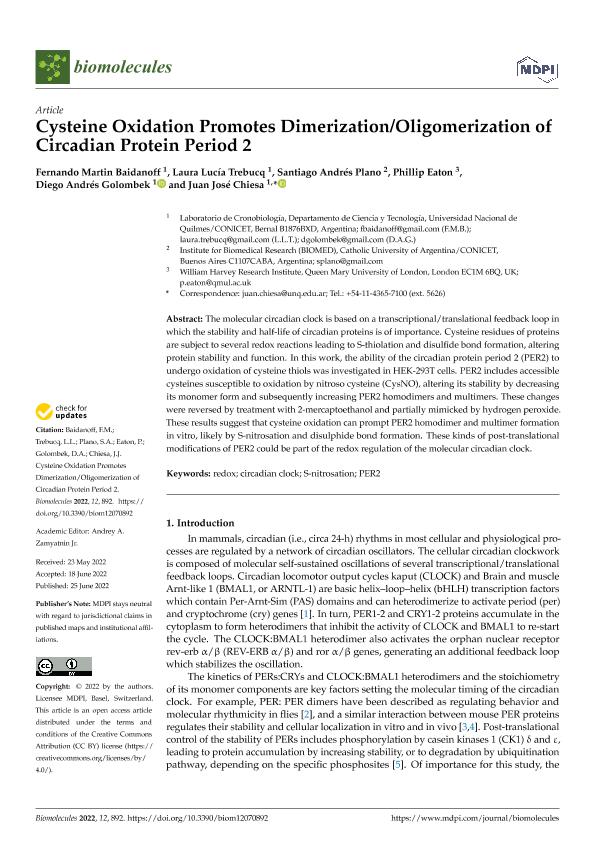Artículo
Cysteine Oxidation Promotes Dimerization/Oligomerization of Circadian Protein Period 2
Baidanoff, Fernando Martín ; Trebucq, Laura Lucía; Plano, Santiago Andrés
; Trebucq, Laura Lucía; Plano, Santiago Andrés ; Eaton, Phillip; Golombek, Diego Andres
; Eaton, Phillip; Golombek, Diego Andres ; Chiesa, Juan José
; Chiesa, Juan José
 ; Trebucq, Laura Lucía; Plano, Santiago Andrés
; Trebucq, Laura Lucía; Plano, Santiago Andrés ; Eaton, Phillip; Golombek, Diego Andres
; Eaton, Phillip; Golombek, Diego Andres ; Chiesa, Juan José
; Chiesa, Juan José
Fecha de publicación:
07/2022
Editorial:
MDPI
Revista:
Biomolecules
ISSN:
2218-273X
Idioma:
Inglés
Tipo de recurso:
Artículo publicado
Clasificación temática:
Resumen
The molecular circadian clock is based on a transcriptional/translational feedback loop in which the stability and half-life of circadian proteins is of importance. Cysteine residues of proteins are subject to several redox reactions leading to S-thiolation and disulfide bond formation, altering protein stability and function. In this work, the ability of the circadian protein period 2 (PER2) to undergo oxidation of cysteine thiols was investigated in HEK-293T cells. PER2 includes accessible cysteines susceptible to oxidation by nitroso cysteine (CysNO), altering its stability by decreasing its monomer form and subsequently increasing PER2 homodimers and multimers. These changes were reversed by treatment with 2-mercaptoethanol and partially mimicked by hydrogen peroxide. These results suggest that cysteine oxidation can prompt PER2 homodimer and multimer formation in vitro, likely by S-nitrosation and disulphide bond formation. These kinds of post-translational modifications of PER2 could be part of the redox regulation of the molecular circadian clock.
Palabras clave:
CIRCADIAN CLOCK
,
PER2
,
REDOX
,
S-NITROSATION
Archivos asociados
Licencia
Identificadores
Colecciones
Articulos(BIOMED)
Articulos de INSTITUTO DE INVESTIGACIONES BIOMEDICAS
Articulos de INSTITUTO DE INVESTIGACIONES BIOMEDICAS
Articulos(SEDE CENTRAL)
Articulos de SEDE CENTRAL
Articulos de SEDE CENTRAL
Citación
Baidanoff, Fernando Martín; Trebucq, Laura Lucía; Plano, Santiago Andrés; Eaton, Phillip; Golombek, Diego Andres; et al.; Cysteine Oxidation Promotes Dimerization/Oligomerization of Circadian Protein Period 2; MDPI; Biomolecules; 12; 7; 7-2022; 1-10
Compartir
Altmétricas



